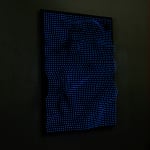Garage Inventors
This exhibition features artists who exemplify the ethos of Silicon Valley in the form of the genius “garage” inventor. Many of these artists have deep roots in the Bay Area, as well as a streak of “mad scientist” that they harness to make works of brilliant technical, conceptual and aesthetic innovation. Yet their works are more than high-tech marvels. They are infused with uniquely human qualities – emotion, perception, intelligence – that elicit from the viewer an unavoidable connection and reaction.
Artists include Jim Campbell, Tim Hawkinson, Alan Rath, Charles Lindsay, Nam June Paik, Rachel Sussman, and Gail Wight.
Jim Campbell received degrees in engineering and mathematics from MIT and has been based in San Francisco since 1980. His work probes the limits of perception with extremely low-resolution imagery through hand-made, LED-based sculptures. Campbell’s work is unique in that his medium and message are inseparable: he uses technologies developed for information transfer and storage to explore human perception and memory.
Tim Hawkinson (born 1960, San Francisco) received his BFA from San Jose State University before moving to Los Angeles. Hawkinson’s creative output channels the qualities of virtuoso tinkerer and prodigious alchemist. For this exhibition he has reconfigured a bicycle into a whistle that plays notes encoded in the notches of the bike’s rear-wheel tread pattern.
An MIT-educated engineer based in San Francisco for 30 years, Alan Rath builds electronic sculptures infused with uncannily life-like characteristics. Incorporating LCD screens and custom-designed robotic armatures, the works’ digital and mechanical movements are algorithmically generated sequences with an infinite progression of permutations.
Stanford Art Professor Gail Wight works primarily in sculpture, video, interactive media and print to construct biological allegories that tease out the impacts of life sciences on the living: human, animal, and other. The interplay between art and biology, theories of evolution, cognition and the animal state-of-being are themes that are central to her investigations.
The ultimate pioneer in the genre of new media, Nam June Paik was a Korean American artist (born 1932 in Seoul, died 2006) widely credited as the founder of video art and among the first artists to envision the radical implications of an ‘electronic super highway’ and cybernetics. He co-created the Abe-Paik video synthesizer in the 1960s, which became a key element in his future work involving altered TV sets reconfigured into cyborg sculptures and installations.
Born in San Francisco, Charles Lindsay began his career as an exploration geologist and is currently the SETI (Search for Extraterrestrial Intelligence) Institute’s Artist-In-Residence Program Director. His multi-disciplinary practice involves immersive environments, sound installations, and sculptures built from salvaged aerospace and bio-tech equipment, photographs and videos.
Based in Brooklyn, Rachel Sussman recently completed a critically acclaimed, decade-long project, “The Oldest Living Things in the World,” that combines art, science, and philosophy into a traveling exhibition and New York Times bestselling book. In her latest project, working with SpaceX, NASA, and CERN, Sussman has created a 120-foot long, handwritten timeline of the universe that begins before the Big Bang and extends 10 to the 100 billion years into the future. “(Selected) History of the Spacetime Continuum” conceptually weaves together astrophysics, geology, biology, mathematics, archeology, history, Einsteinian relativism, and chronocriticism—the study of time itself.











